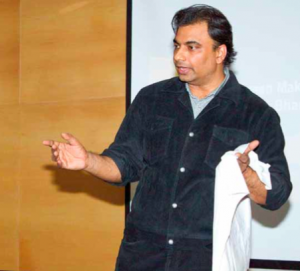 DMI’s first exclusive, comprehensive workshop on direct-to-garment
DMI’s first exclusive, comprehensive workshop on direct-to-garment
textile screen printing process with live demo was successfully
conducted by Bhargav Mistry, Director of DMI, an industry initiative
of Grafica Flextronica, a manufacturer and exporter of screen printing
machines and allied products. Over 40 participants from India’s
textile and garment industry attended the workshop held on April 5, 6
and 7. Interestingly, barring a couple of participants, the rest said
that this was their first-ever workshop on garment printing.
“I was overwhelmed by the enthusiasm of the participants on all the
three days,” said Bhargav while commenting on the objective of the
workshop.
As a part of the workshop practical, T-shirts with different designs
were screen-printed using nano-prinTex. The objective of the live demo
was to demonstrate the printing techniques of CMYK process colour,
spot separation, high density and special effects (glitter and silver
effects) using water based and plastisol inks. There was also live
demo of the textile heat transfer printing.
 At the theory sessions, Bhargav covered the entire gamut of screen
At the theory sessions, Bhargav covered the entire gamut of screen
printing, such as file handling, designing, pre press, right method of
screen making techniques needed to achieve higher quality in printing,
techniques of direct-to-garment printing using advanced machines,
drying/curing process, high quality inks and chemicals, etc.
In the feedback forms, the participants said they found the right
solutions and tips at DMI for some of their major problems such as
pre-press, management, screen exposing, half-tone printing, lower
productivity and poor quality, screen choke up, dot gain, problem in
registration, moiré problem, 4-colour printing, lack of
standardisation, colour separation, spot colour printing, mesh
selection, lack of technical knowledge of inks, chemicals and
consumables, rejections, wastage, labour issues, lack of clean
environment, lack of knowledge about drying/curing methods, and manual
screen printing.
“I think these numerous problems reflect how direct-to-garment screen
printers (both manual and machine users) suffered for so many years in
the absence of proper guidance and knowledge. I think knowledge in
textile screen printing technique is much needed to take Indian
garment export to a greater height,” said Bhargav during his
presentation.
“We for one have taken up the challenge to impart advanced screen
printing knowledge for direct-to-garment screen printers, garment
manufacturers, exporters and buying houses,” he added.